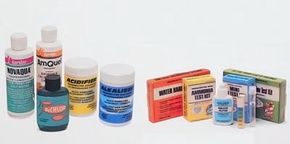Chemical Aquarium Filtration
Chemical aquarium filtration is needed because a number of dissolved, invisible compounds accumulate in aquarium water and they can't be removed by mechanical filtration.
These compounds are not toxic to the fish but can inhibit their growth and cause chronic, low-level stress that eventually leads to disease. Most of these compounds are dissolved organic substances produced by natural biological decay.
Advertisement
The dissolved organic substances eventually reach concentrations high enough to become visible as a yellowish tinge in the water. You can see this when a sheet of white paper is held behind the tank so that half of it is viewed through the water.
If the water is healthy for the fish, the paper viewed through the water will be as white as the other half; if not, the paper will have a yellowish cast to it.
Chemical filtration removes many, but not all, of these compounds. However, some substances that affect the growth of the fish can only be removed by making partial water changes on a regular basis.
If this isn't done, the fish will never grow to normal adult size. This stunted growth will result in fish that never achieve the beauty of mature fish, and it can cause other related health problems.
There are many ways to accomplish chemical filtration, but for all practical purposes, the only method that is both effective and relatively economical is to pass the aquarium water over granular activated carbon.
Granular activated carbon is usually made from an organic material, such as coconut shells, that is ground into small pieces and then heated to 2,000° Fahrenheit to drive off gases in the material. This "activation" produces carbon that can adsorb the molecules of compounds in the water and hold on to them. Adsorption is the adhesion of a thin layer of molecules to a solid (in this case, the activated carbon).
The carbon eventually becomes saturated with molecules and must be replaced. It cannot be reactivated by hobbyists because of the special ovens needed for the process.
Granular activated carbon should not be confused with charcoal, which is sold in some stores at a much lower price but does not provide effective chemical filtration.
There are a few things to keep in mind when using granular activated carbon. The smaller the granules of carbon, the greater the total surface area available to adsorb molecules for any given amount of carbon. The total surface area of the carbon determines how long you can wait before it is necessary to replace it.
A good rule of thumb is to use one ounce of carbon for every four gallons of water. If the tank is not overstocked with fish, the carbon should last at least a month and probably twice that.
See the next section to learn about biological aquarium filtration.
